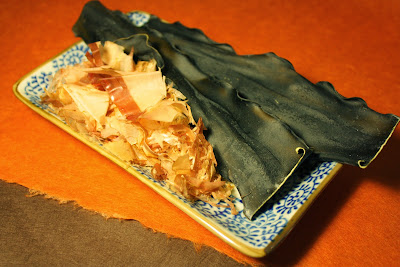Dashi (Konbu and Katsuobushi) - Basic Japanese stock
Ingredients:
4 cups water
1 strip konbu, 14 cm in length
40g katsuobushi, divided
Directions for Ichiban-dashi (first stock):
This first preparation of dashi is best for clear soups like little neck clam soup, or for chawanmushi.
1. Wipe off the konbu then leave it to soak in cold water for 20 minutes.
2. Put the konbu in a pot with 4 cups of water and turn heat on high. Just before the water starts to boil, remove the konbu.
3. Add 30 g of the katsuobushi to the boiling water and turn down the heat a little. Skim off any foam that forms at the surface as the stock simmers. Turn off heat.

4. Allow the katsuobushi to fall to the bottom of the pot, then strain with a fine mesh colander or through cheesecloth.
Directions for Niban-dashi (second stock):
Squeeze out even more flavor for a second stock which can be used for simmering or for miso soup.
1. Put the used konbu and katsuobushi back on the stove and, with another 3 cups of water, put the heat on low.
2. When it reaches boiling point, add 10 g more of the katsuobushi and remove the foam as it simmers. Turn off heat and strain as instructed above.
How I made out:
Why did I think this was so complicated? There are only two ingredients! Whatever, I still managed to screw up the part in Step 3 where you have to turn down the heat after adding the katsuobushi (as evidenced in the picture). Luckily I didn’t let it go too long. The dashi had a mild, smoky, campfire-flavor and, the next morning, my kitchen even smelled like I had a campfire going the night before.
The verdict:
The instant dashi is great for convenience, but if you can get your hands on some konbu and katsuobushi, you’ll see that it only takes a few minutes to make, and the finished product is free of preservatives and much more economical.








It would be wonderful for you to be able to get these great asian ingredients to make your own stock. I made a dish with udon noodles this evening. The recipe said to blanch them, but they were a little soggy :(
ReplyDeleteand they went cold quickly. If you know how the Japanese overcome this problem?
Hi Julie,
ReplyDeleteIf the dish is a soup, usually the noodles would be blanched seperately and then added to hot dashi just before serving to keep them from getting soggy.
Were you using dried, fresh or frozen noodles? Frozen noodles can be dropped into boiling water and taken out once the noodles have separated. It usually takes one minute.
With dried noodles, add them to boiling water and then add a cup of cold water. Wait till the water gets to boiling temperature again, then add another cup of cold water. Repeat the process for as long as it takes to get the noodles al dente.
Hope this helps!
Thanks for your feedback. They were dried noodles and I shall try the cold water method next time around. Thanks Florence!
ReplyDelete